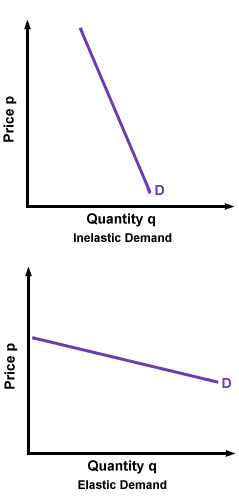Elasticity - Economy | SSC CGL Tier 2 - Study Material, Online Tests, Previous Year PDF Download
What is Elasticity?
Elasticity pertains to the extent of responsiveness in supply or demand concerning fluctuations in price. When a curve exhibits higher elasticity, minor price adjustments lead to substantial variations in the quantity consumed. On the other hand, a curve with lower elasticity requires significant price changes to influence a shift in quantity consumed. Graphically, elasticity is visually represented by the characteristics of the supply or demand curve. A more elastic curve appears horizontal, while a less elastic curve tilts more vertically. In the context of elasticity, the term "flat" is used for horizontal curves, and a "flatter" elastic curve is closer to being perfectly horizontal.
 Elastic and Inelastic Curves
Elastic and Inelastic Curves
At the extremes, a perfectly elastic curve will be horizontal, and a perfectly inelastic curve will be vertical. Hint: You can use perfectly inelastic and perfectly elastic curves to help you remember what inelastic and elastic curves look like: an Inelastic curve is more vertical, like the letter I. An Elastic curve is flatter, like the horizontal lines in the letter E. Perfectly Elastic and Perfectly Inelastic Curves
Perfectly Elastic and Perfectly Inelastic Curves
The price elasticity of demand, often termed as demand elasticity, signifies the extent to which the quantity demanded responds to changes in price. In the scenario depicted below, where demand is highly elastic (displaying a nearly flat curve), observe that a shift in price from $0.75 to $1 results in a substantial reduction in quantity. Various factors can contribute to this phenomenon. Buyers might possess the ability to easily substitute alternatives for the product, making them highly sensitive to price fluctuations. Alternatively, the limited desire for the product could mean that even a minor price change significantly impacts the demand for the good.

In the case of very inelastic demand, significant alterations in price have minimal impact on the quantity demanded. For example, while a 25-cent price change results in a reduction of 6 units in the elastic curve illustrated above, the inelastic curve below indicates that a substantial price increase of one dollar only diminishes demand by 2 units. In scenarios characterized by inelastic curves, substantial price jumps are necessary to induce changes in demand on the graph. This circumstance may arise when the good in question is essential and lacks easy substitutes. In essence, for goods with an inelastic curve, consumers possess a strong desire or need for the product, and viable alternatives are not readily available. Consequently, consumers tend to maintain consistent purchases of the good regardless of price fluctuations.

Like demand, supply also has varying degrees of responsiveness to price, which we refer to as price elasticity of supply, or the elasticity of supply. An inelastic supplier (one with a steeper supply curve) will always supply the same amount of goods, regardless of the price, and an elastic supplier (one with a flatter supply curve) will change quantity supplied in response to changes in price.
Measuring Elasticity: A Formulaic Approach
To gauge elasticity, one can draw parallels between the relative steepness or flatness of a supply or demand curve. Consequently, the formula for elasticity calculation mirrors the formula for slope computation. Instead of directly comparing actual prices and quantities, elasticity delves into the correlation between changes in price and quantity. The elasticity coefficient is determined by dividing the percentage change in quantity by the percentage change in price, expressed as:
It is essential to note that when computing percentage changes, the values can be positive or negative. However, elasticity is always considered an absolute value. Even in cases where an increase in price accompanies a decrease in quantity (common with most demand curves), the elasticity remains positive. To find the final value for elasticity, any minus signs are disregarded.
To apply this concept, let's solve for the elasticity in the market for ping pong balls. When the price is $1 each, Alice is willing to buy 10 balls, and Joe is willing to sell 10 balls. If the price rises to $1.50 each, Alice is willing to buy 6 balls, and Joe is willing to sell 20. Calculating Alice's price elasticity of demand:

Similarly, for Joe's price elasticity of supply:
|
1650 videos|1642 docs|920 tests
|





















